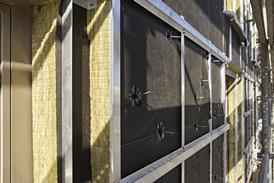By joining the drive to halve waste sent to landfill, construction companies have committed themselves to improving their waste management. here are two free software tools that can help firms get to grips with the challenge
Site waste management is something the construction industry can no longer ignore. The landfill tax escalator is set to drive up business waste disposal costs – firms in the building industry are already paying about £1bn a year to send their 25 million tonnes of waste to landfill. And since April it has been mandatory in England for all projects worth more than £300,000 to use site waste management plans.
SWMPs aim to identify the key factors in managing and reducing waste – the types of waste generated, waste management options for those streams and the use of appropriate contractors. Firms can then draw up a plan for monitoring and reporting waste quantities, appointing an individual to handle waste management on site.
To facilitate this process, tools are emerging to help construction firms manage waste more efficiently.
Net Waste Tool
This management tool was launched in April by WRAP, and updated in September, to help firms that have signed up to the voluntary target to halve waste sent to landfill by 2012. The Net Waste Tool is available free to designers, contractors and clients to help them move towards good waste management practice. In some instances, using it will result in a cost saving.
“The old adage that ‘you can’t manage what you don’t measure’ is as true when it’s applied to construction waste as to anything else,” says Dr David Moon, construction programme manager for clients and policy at WRAP. “WRAP’s Net Waste Tool is a user-friendly way to identify the top opportunities to cut the costs of wasted materials and waste disposal.”
The tool, accessible via the WRAP website, is for use at the design stage of a project. It helps the user identify, for example, the top 10 components to target for a lower wastage rate on a project and the top 10 changes in materials purchasing that can increase reused and recycled content.
It also allows actual project data to be entered – for instance, from the SWMP – and compared against forecasts. It is intended for use on larger commercial and housing developments and on public sector projects.
Typically, the project QS or cost planner enters design stage data (RIBA stage C or D) into the Net Waste Tool. The software uses basic project parameters such as floor area and number of storeys to estimate quantities of materials, and then the user selects the specifications for each building element from a list of stored options. The user can also overwrite the assumed quantities, costs and other parameters.
“The Net Waste Tool estimates the amount of waste that will be generated at baseline and good industry practice, the value of wasted materials and the optimum segregation strategies. This allows the user to reduce wastage and effectively manage residual waste,” says Moon. “It also estimates the user’s savings in materials and waste management costs and the savings in landfill and carbon impact.”
Wates Construction is an early user of the tool. Its environmental manager, Matthew Browne, says: “It’s straightforward to get started. By entering bill of quantities data, skip costs and an outline programme, it produces a full assessment of recycled content, estimates waste quantities and gives us areas to improve. It also produces input data for a full site waste management plan, calculates what skips we need during which stage of the programme and tells us how much it will all cost.”
The software has enabled Wates cut waste, save on landfill costs and reduce the company’s carbon footprint, says Browne. “It helped us to focus. When asked to reduce waste, a lot of people struggle to know where to begin, so the tool is a good starting point.
“We’ve been surprised at how simple some of the measures to reduce waste on site can be,” he adds. “We’re preparing to roll out training on using the Net Waste Tool to our pre-construction teams before the end of the year.”
As well as financial and environmental savings, Browne believes the software can help contractors secure business. “I think the tool has potential to help deliver better, more efficient building projects for our customers,” he says. “Anything that helps deliver more efficient projects, reduce environmental impact and drive down costs has got to be of interest.”
Reporting Tool
Another software tool for signatories to the campaign to halve waste to landfill, the Reporting Tool, will be available from WRAP in February.
Moon explains its role: “The Reporting Tool will be a relatively simple web portal to support the monitoring of progress against the government-industry target for halving waste to landfill by 2012. Organisations that sign up to the halving waste voluntary agreement will be invited to register their own corporate target and provide data on their baseline performance.”
Using the tool, each organisation will report annual corporate totals for waste generated, waste to landfill and total construction output, he explains.
“The tool then calculates progress against baseline for key performance indicators such as waste reduction – and also shows how different market segments have contributed collectively. WRAP will work with sector bodies where appropriate to encourage reporting by their members and demonstrate achievement,” says Moon.
Postscript
This article previously appeared in the WRAP-sponsored supplement, “Halving Waste to Landfill: Are you Committed?”
The Wrap supplement 2008
- 1
- 2
- 3
 Currently reading
Currently readingSoft option: free technology tools to help firms with the waste management task at hand
- 4
- 5
- 6
- 7
- 8
- 9
- 10
- 11




































No comments yet